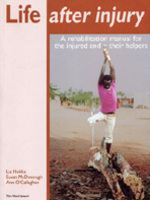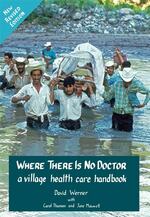
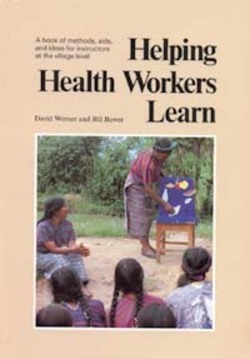
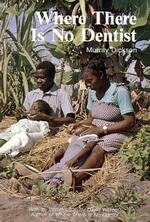
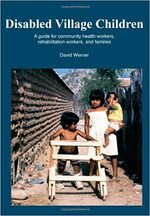
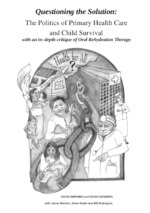
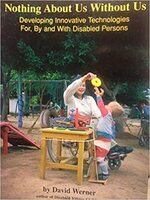

HealthWrights: Books
Where There Is No Doctor, which began as a modest Spanish-language medical handbook (Donde No Hay Doctor) written for the local health workers of the Sierra Madre, ended up influencing the global health movement, and spawning grassroots publishing efforts that continue to this day.
Books published by HealthWrights are available in electronic form for free.
Publications associated with HealthWrights may be free or a purchase link will be provided below.
Books published by Hesperian Foundation are available from their site in free digital format (PDF), and for purchase from their (website). Visit their Books and Resources to explore their list of freely available publications, including Where There Is No Doctor, Helping Health Workers Learn, Where There Is No Dentist, and Disabled Village Children. To access Hesperian’s library by language, visit their language-list.
Para Libros en Español, clic aquí.
-
2019:
Reports From the Sierra Madre: Stories Behind the Health Handbook Where There Is No Doctor
-
Reports from the Sierra Madre comprises an on-the-spot journal of the first year David Werner spent as a novice health worker in the isolated villages of the Sierra Madre, the rugged mountain range of western México, in the state of Sinaloa. Planning only to stay a year in 1966, his engagement with the Sierra Madre spanned half a century, and had a far-reaching impact. These four reports–here published together for the first time–were initially scribbled by lamplight and sent in serial form to friends to raise funds for this unlikely grassroots endeavor. Over two hundred photos, paintings and drawings by the author have been added to the original text.
-
-
1998:
Nothing About Us Without Us: Developing Innovative Technologies For, By and With Disabled Persons
-
Nothing About Us Without Us is a book of true stories about people’s creative search for solutions and is a companion to David Werner’s earlier Disabled Village Children. The book explores the development of innovative aids and equipment that can be made at low cost at home or in a small community workshop. Yet it also considers how to achieve fuller integration of disabled people into society: ways to help communities look at disabled persons' strengths, not their weaknesses. Examples of Child-to-Child activities show how disabled and non-disabled children can work, play and learn together, to enrich one another’s lives.
-
-
1997:
Tiger's Fall
-
Wild, energetic Lupe, 11, loses all hope after a fall from a tree leaves her paralyzed below the waist. Her surgery drives her struggling family into debt, and Lupe just wants to die. It’s in a village center for the disabled—run by the disabled—that she finds that she can be more than a “helpless cripple.” Of course, this is as much a message as a story, the rehabilitative center is based on a real place that Bang visited in western Mexico, and the drama is in the factual detail. [...] The disabled and those who love them will appreciate the truth of Lupe’s anger and depression and her struggle to find her own kindness and courage.
-
-
1997:
Questioning the Solution: The Politics of Primary Health Care and Child Survival
-
Questioning the Solution analyzes why 13 million children still die every year from preventable causes and challenges conventional Primary Health Care and Child Survival Strategies. As a case study, the authors show how marketing Oral Rehydration Therapy as a commercial product, rather than encouraging self-reliance, has turned this potentially life-saving technology into yet another way of exploiting and further impoverishing the poor. The book explores the history of medicine and public health since colonial times and shows that health is determined more by the equity or inequity of social structures than by conventional health services.
-
-
1997:
Life after Injury: A Rehabilitation Manual for the Injured and their Helpers
-
Life After Injury is a practical handbook for people who wish to help those injured as a result of accidents, landmines or armed conflict. It is written from extensive experience infolving work with village health workers, injured and disabled people, their families and communities. The aim is to build sustainable local capacity for rehabilitation at the village level in the poorest communities in the world. The down-to-earth approach covers a wide range of related problems and needs. These extend from the event of the injury, through emergency care, hospitalization (when possible), learning to do daily activities and finally reintegration into the community. The book also promotes the use of low-cost appropriate technology, splints and aids, training, teamwork and community education.
-
-
1987:
Disabled Village Children: A Guide for Community Health Workers, Rehabilitation Workers, and Families
-
Disabled Village Children contains a wealth of clear and detailed information, as well as easy-to-implement strategies for all who are concerned about the well-being of children with disabilities. This manual, written especially for those who live in communities with limited resources, explains how to create small community rehabilitation centers and workshops run by either disabled people or the families of children with disabilities. More than 4000 drawings and 200 photos make Disabled Village Children understandable to all.
-
-
1983:
Where There Is No Dentist
-
This book is an important companion to the classic book Where There Is No Doctor. Community health workers, educators and individuals from around the world use Where There Is No Dentist to help people care for their teeth and gums. The author uses straightforward language and careful instructions to explain how to examine patients, diagnose common dental problems, make and use dental equipment, use local anesthetics, place fillings, and remove teeth. There is also a special chapter on oral health and HIV/AIDS, which provides the dental worker with a detailed, well-illustrated discussion of the special problems faced by people living with HIV/AIDS, and appropriate treatment.
-
-
1982:
Helping Health Workers Learn: A Book of Methods, Aids, and Ideas for Instructors at the Village Level
-
Helping Health Workers Learn is an indispensable resource for all health educators. This heavily illustrated book shows how to make health education engaging and effective, while emphasizing a people-centered approach to care. It also presents strategies for effective community involvement through participatory education. Topics include (a) activities for mothers and children, (b) tips for using theater, flannel-boards, and other techniques, (c) strategies for producing low-cost teaching aids, (d) and how to build on a community’s strengths, experiences, and strengths.
-
-
1977:
Where There Is No Doctor: A Village Health Care Handbook
-
Where There Is No Doctor is perhaps the most widely-used health care manual for health workers, clinicians, and others involved in primary health care delivery and health promotion programs around the world. With millions of copies in print in more than 75 languages, the manual provides practical, easily understood information on how to diagnose, treat, and prevent common injuries and illnesses. Special attention is focused on nutrition, infection and disease prevention, and diagnostic techniques as primary ways to prevent and treat health problems.
-




